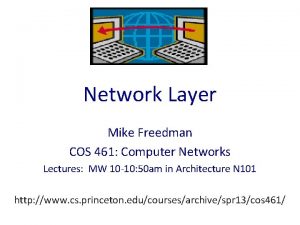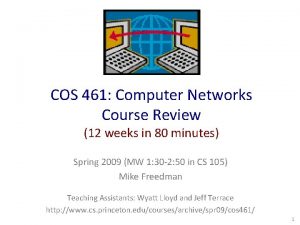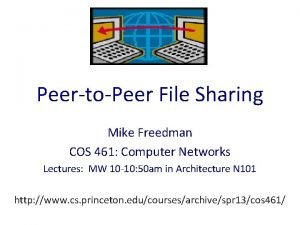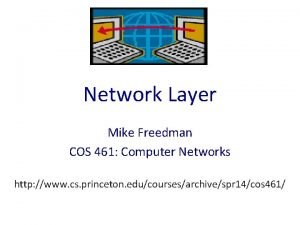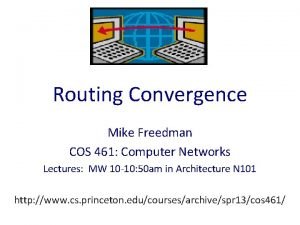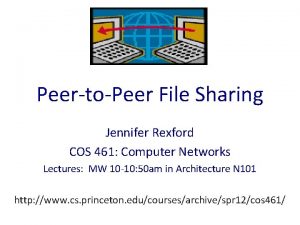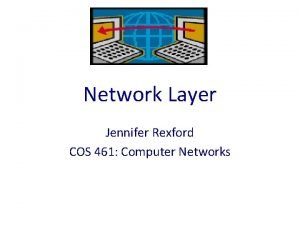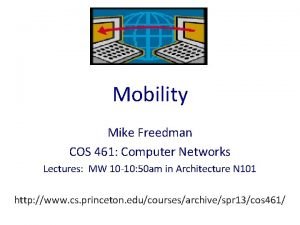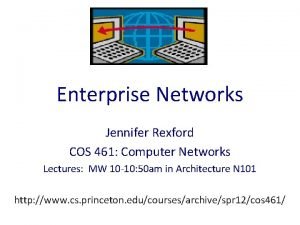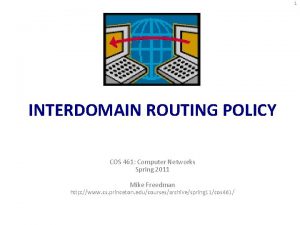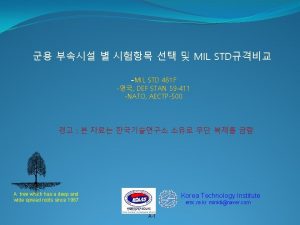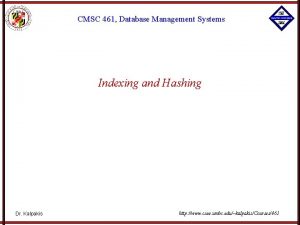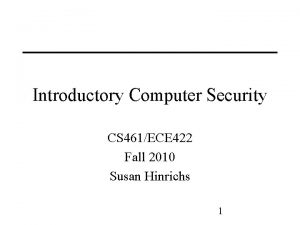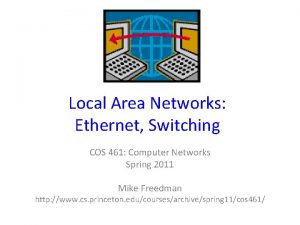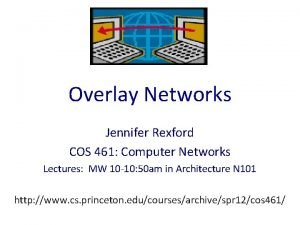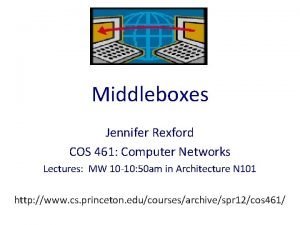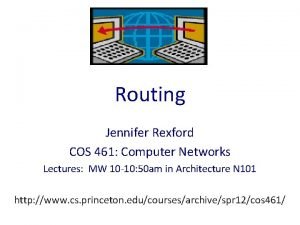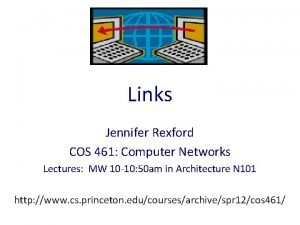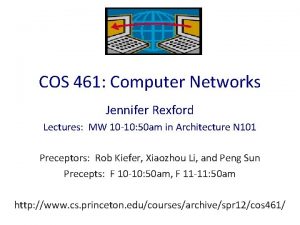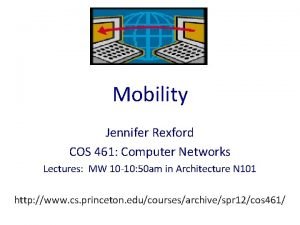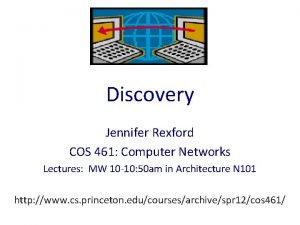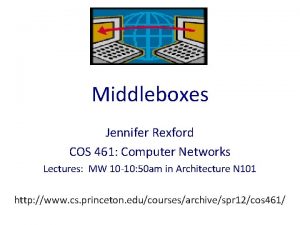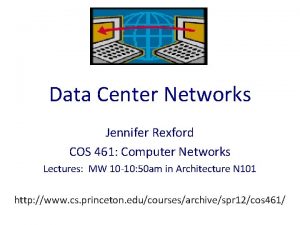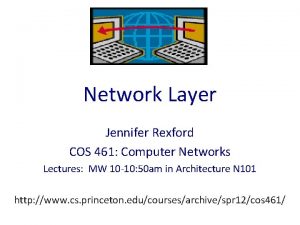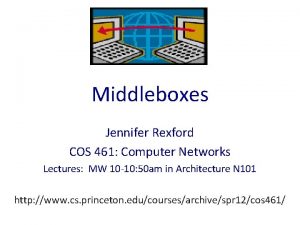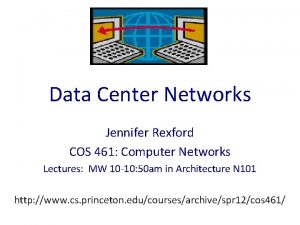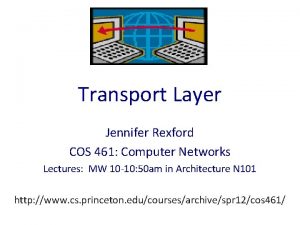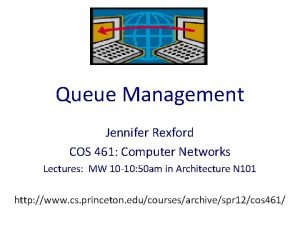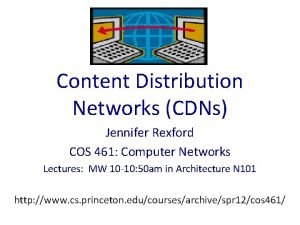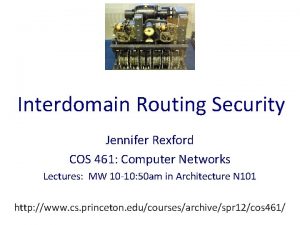Enterprise Networks Jennifer Rexford COS 461 Computer Networks









































- Slides: 41

Enterprise Networks Jennifer Rexford COS 461: Computer Networks Lectures: MW 10 -10: 50 am in Architecture N 101 http: //www. cs. princeton. edu/courses/archive/spr 12/cos 461/

Networking Case Studies Data Center Enterprise Backbone Cellular Wireless 2

Simple Enterprise Design • Single layer-two subnet • Local services – Hubs and switches – Gateway to the Internet – Single IP address block S 1. 2. 3. 1 S – DHCP – DNS DHCP server 1. 2. 3. 0/24 Internet G 1. 2. 3. 76 0. 0/0 S 1. 2. 3. 5 1. 2. 3. 150 S DNS server 3

Limitations of Simple Design • Ethernet scalability and performance • Single ISP reliability and performance • Limited IP address space S 1. 2. 3. 1 S • Unwanted Internet traffic • Privacy and isolation within the enterprise • Detecting and preventing bad behavior from inside DHCP server 1. 2. 3. 0/24 Internet G 1. 2. 3. 76 0. 0/0 S 1. 2. 3. 5 1. 2. 3. 150 S DNS server 4

Beyond Ethernet Switching 5

Scalability Limitations of Ethernet • Spanning tree – Paths that are longer than necessary – Bandwidth wasted for links not in the tree • Forwarding tables – Bridge tables grow with number of hosts • Broadcast traffic – ARP, DHCP, and broadcast applications • Flooding – Frames sent to unknown destinations 6

Hybrid of Switches and Routers 1. 2. 3. 0/26 R Ethernet Bridging - Flat addressing - Self-learning - Flooding - Forwarding along a tree R IP Routing - Hierarchical addressing - Subnet configuration - Host configuration - Forwarding along shortest paths 1. 2. 3. 192/26 R R 1. 2. 3. 128/26 R 1. 2. 3. 64/26 7 Internet

Limitations of Hybrid Design • No plug-and-play and mobility between subnets • Need consistency between IP addressing & routing 1. 2. 3. 0/26 R 1. 2. 3. 192/26 R R R 1. 2. 3. 128/26 8 R 1. 2. 3. 64/26 Internet

Virtual Local Area Networks 9

Early Days of Ethernet LANs • Thick cables snaked through cable ducts – Every computer they passed was plugged in • All people in adjacent offices on the same LAN – Whether they belonged together or not • Users grouped based on physical layout – Rather than organizational structure • Security, privacy, and scalability limitations… 10

Today’s Ethernet LANs • Changes introduced by hubs and switches – Every office connected to central wiring closets – Often multiple LANs (k hubs) connected by switches – Flexibility in mapping offices to different LANs • Can group by organizational structure – Better privacy: snooping in promiscuous mode – Separate IP addresses: one IP subnet per LAN – Better security: access control at IP routers – Better load management: isolate broadcast/flooding 11

People Move, and Roles Change • Organizational changes are frequent – E. g. , faculty office becomes a grad-student office – E. g. , graduate student becomes a faculty member • Physical rewiring is a major pain – Requires unplugging the cable from one port – … and plugging it into another – … and hoping the cable is long enough to reach • Would like to “rewire” the building in software – The resulting concept is a Virtual LAN (VLAN) 12

Example: Two Virtual LANs R RO O R R O O R R Red VLAN and Orange VLAN Switches forward traffic as needed 13

Making VLANs Work • Changing the Ethernet header – Adding a field for a VLAN tag – Implemented on the bridges/switches – … but can still interoperate with old Ethernet cards • Bridges/switches trunk links – Saying which VLANs are accessible via which interfaces • Approaches to mapping access links to VLANs – Each interface has a VLAN color – Each MAC address has a VLAN color 14

Uses of VLANs (See the Survey Paper) • Scoping broadcast traffic • Simplifying access control policies • Decentralizing network management • Enabling host mobility 15

Problem: Limited Granularity • Limited number of VLANs – Placing multiple groups in the same VLAN – Reusing limited VLAN • Limited number of hosts per VLAN – Divide a large group into multiple VLANs • One VLAN per access port – Supporting VLANs on the end host – Supporting multiple groups at the router 16

Problem: Complex Configuration • Host address assignment – Wasting IP addresses – Complex host address assignment • Spanning tree computation – Limitation of automated trunk configuration – Enabling extra links to survive failures – Distributing load over the root bridges Open question: can we do better than VLANs? 17

Multiple Internet Connections 18

Motivation for Multi-Homing • Benefits of multi-homing – Extra reliability, e. g. , survive single ISP failure – Financial leverage through competition – Better performance by selecting better path – Gaming the 95 th-percentile billing model ISP 1 ISP 2 1. 2. 3. 0/24 19

Multi-Homing Without BGP Inbound Traffic Outbound Traffic • Ask each ISP to originate the IP prefix • … to rest of the Internet • One ISP as a primary, the other as a backup • Or simple load balancing of all traffic ISP 1 ISP 2 1. 2. 3. 0/24 20

Multi-Homing With BGP • Inbound traffic • Outbound traffic – Originate the prefix to both providers – Do not allow traffic from one ISP to another ISP 1 – Select the “best” route for each remote prefix – Define BGP policies based on load, performance, cost ISP 2 BGP sessions 1. 2. 3. 0/24 “Intelligent route control” or “multi-homed traffic engineering”. 21

Interconnecting Multiple Enterprise Sites 22

Challenges • Challenges of interconnecting multiple sites – Performance – Reliability – Security – Privacy • Solutions – Connecting via the Internet using secure tunnels – Virtual Private Network (VPN) service – Dedicated backbone between sites 23

Connecting Via the Internet • Each site connects to the Internet – Encrypted tunnel between each pair of sites – Packet filtering to block unwanted traffic – But, no performance or reliability guarantees Site 1 Internet Site 2 Site 3 24

Virtual Private Network (VPN) • Each site connects to a common VPN provider – Provider allows each site to announce IP prefixes – Separate routing/forwarding table for each customer – Performance guarantees Site 1 VPN Provider Site 2 Site 3 25

Middleboxes 26

Enterprise Internet Connection • Multiple middleboxes – Intrusion prevention system – Network address translator – Firewall – Traffic shaper • Handling bad internal users – Filtering IP packets with spoofed source IP addresses – Logging which MAC address has each IP address Internet M link M M R 27

Internal Middleboxes • Network divided into regions – E. g. , departments within a campus – E. g. , public computers (servers, Wi. Fi) vs. private • Network divided by roles – E. g. , human resources vs. engineering – E. g. , faculty vs. students • Sometimes physically separate networks – E. g. , ATM machines, campus safety, media streaming 28

�Princeton Campus Network http: //www. net. princeton. edu/index. html http: //www. net. princeton. edu/statistics/ http: //www. net. princeton. edu/whatsnew. html 29

Internet Connections Comcast (full routes) Wind. Stream (full routes) ESnet 1 Gbps MAGPI/Internet 2 1 Gbps vgate 1 1 Gbps Princeton Campus • Two commercial ISPs: Comcast and Wind. Stream • Two research networks: ESnet and Internet 2 • Non-profits: Mc. Carter Theater, Princeton Public Library, and Princeton Regional Schools 30

Princeton Public Internet Traffic • Traffic volumes over the past week – Green: traffic from the Internet – Blue: traffic to the Internet 31

Three Internal Networks • Campus Data Network – Connects dorms, academic and administrative buildings, campus Wi. Fi, etc. • Princeton Private Network – Environmental systems, power, security cameras, building locks • Vo. IP Network – Vo. IP phones in data center, chemistry, neuroscience, Forrestal campus, and all new construction – Separate for disaster recovery & traffic management 32

Campus Data Network Internet vgate 1 RIP routing Dormnet Academic, administrative gigasw 2 gigasw 4 gigagate 1 Applications Data Center 33

Data Center (Forrestal Campus) • 40, 000 square feet with 1800 computers • Multiple tiers of backup power • Minimizes energy for cooling and power 34

Virtual Private Network (VPN) • Online campus resources – E. g. , some Princeton University library resources – Not available from outside of campus • External resources with Princeton subscription – E. g. , digital libraries from ACM and IEEE – Accessible from a Princeton IP address • Princeton VPN service (vpn. princeton. edu) – Secure network connection layered over IP network – … connects you to an internal Princeton machine 35

Aruba Wi. Fi Access Points • Adaptive radio management – Automatically assigns channel and power settings – Channel load balancing to distribute clients – Coverage hole detection 36

Wi. Fi Anecdote (puwireless) • Single large VLAN – Enabling seamless mobility on campus • Limited address space – 16 K or 32 K IP addresses – 3 hour DHCP leases • Frequently a large number of users – Several thousand to up to 10, 000 – … may soon run low on IP addresses 37

Wi. Fi Anecdote (puwireless), Continued • Bug in Android and IOS smart phones – Don’t release DHCP lease on IP addresses – Offloads ARP processing to the chipset, to avoid waking up sleeping device on ARP requests – … but DHCP timeout is handled by the processor • So, can have IP address collisions – DHCP lease expires, but the phone doesn’t know – DHCP server gives the IP address to someone else – … and both devices respond to ARP requests! http: //www. net. princeton. edu/android-stopsrenewing-lease-keeps-using-IP-address-11236. html 38

Wi. Fi Anecdote (puwireless), Continued • Working with Google and Apple on the problem • Longer-term solution – Move to larger, private address block (10. 0/8) – Use network address translation (NAT) to communicate with the public Internet • Benefits – Avoids running out of IP addresses – Introduces long delay before reusing an address – Seems like a good solution, right? 39

Wi. Fi Anecdote (puwireless), Continued • Solution makes troubleshooting harder – Public IP addresses shared by many users – … due to network address translation • Example: DMCA violations – Student downloads copyrighted material on Wi. Fi – Company comes to Princeton to complain • Given IP address, can OIT identify the student? – With NAT, cannot pinpoint a unique MAC address – … without much more detailed (flow-level) logs 40

Conclusions • Enterprise networks – Campuses and companies – Access to local services and the Internet • Challenges – IP address limitations – Hybrid switch and routed network – Load balancing over upstream ISPs – Protecting users and the Internet from each other • Next time: data-center networks 41
 Jennifer rexford
Jennifer rexford Cos 461
Cos 461 Cos 461
Cos 461 Cos 461
Cos 461 Cos 461
Cos 461 Cos 461
Cos 461 Cos 461
Cos 461 Cos 461
Cos 461 Cos 461
Cos 461 Cos 461
Cos 461 Cos
Cos Puwifi
Puwifi Gao rexford conditions
Gao rexford conditions A switch in a datagram network uses
A switch in a datagram network uses Backbone networks in computer networks
Backbone networks in computer networks 461 enneagram
461 enneagram Mil std 461 rs103
Mil std 461 rs103 Cmsc 461
Cmsc 461 Uiuc cs 461
Uiuc cs 461 Cs 461
Cs 461 Ccna voice 640-461 pdf
Ccna voice 640-461 pdf Kkk 461
Kkk 461 Opwekking 461 tekst
Opwekking 461 tekst Mil std 464
Mil std 464 Icvm 461/07
Icvm 461/07 Area 461
Area 461 Uiuc cs 461
Uiuc cs 461 Celebrated on march 17
Celebrated on march 17 Gezang 177
Gezang 177 Contul 4428
Contul 4428 Putting the enterprise into the enterprise system
Putting the enterprise into the enterprise system Putting the enterprise into the enterprise system
Putting the enterprise into the enterprise system Cos 1950°
Cos 1950° Cos c -cos d formula
Cos c -cos d formula Bentuk perkalian dari cos 2a – cos 4a =
Bentuk perkalian dari cos 2a – cos 4a = Sen a cos b sen b cos a
Sen a cos b sen b cos a Intreccio e fabula
Intreccio e fabula Caratteristiche strutturali di un testo
Caratteristiche strutturali di un testo What quadrants can inverse cosine be in
What quadrants can inverse cosine be in Nilai dari 2 sin 112,5° sin 22,5° =
Nilai dari 2 sin 112,5° sin 22,5° = Jika sin a = 3/5, a sudut pada kuadran ii, maka cos a =
Jika sin a = 3/5, a sudut pada kuadran ii, maka cos a = Enterprise networks memphis
Enterprise networks memphis


